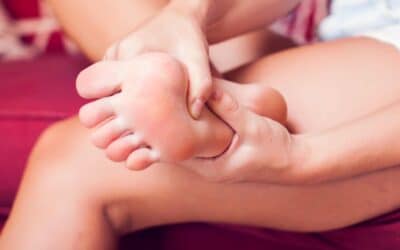As you may well know, good health is a key ingredient for living a fulfilling life. In most cases, conditions such as cancer and heart disease dominate such conversations. However, a condition does not have to be deadly to affect your lifestyle. If you have heel pain, you know all this all too well.
And you’re not alone. While there’s limited information, research suggests that approximately 2 million Americans seek treatment for heel pain each year. Without proper foot care, heel pain can limit your ability to perform day-to-day activities.
But have you also noticed that heel pain fluctuates as the weather changes? If yes, you’re right. In this article, you will learn more about heel pain and how the weather can affect it.
What Is Heel Pain?
Heel pain refers to pain that commonly occurs behind or beneath the heel. However, it can also affect the side of the heel. It is a common foot and ankle problem that mostly occurs due to injury.
During the onset, the pain is mild, and, in most cases, you can recover without treatment. In other instances, it can persist and become chronic, causing severe pain, which can be disabling. Some of the causes of heel pain include:
- Trauma
- Neurological problems
- Arthritis
- Autoimmune problems
- Infection
Depending on where your heel pain is localized, there are different ways to characterize it. These include:
- Plantar fasciitis– pain that occurs beneath the heel
- Achilles’ tendinitis- pain affects the outer and inner side of the foot and heel
Does Weather Affect Heel Pain?
Foot pain can be persistent and occur daily, or something springs up randomly. Regardless of the category, you fall in, you’ll notice that the severity of the pain increases during the winter months.
How can the weather around you affect your heel? In fact, there are multiple ways such as:
1) Low Temperatures
Before going into how low temperature can increase heel pain, it’s vital to appreciate the effect of temperature changes on objects in the environment. Generally, exposure to heat causes objects to expand, while cooling causes them to shrink.
This also happens with some parts of your body, such as tendons, muscles, and other connective tissues. They shrink a little and become more rigid and fragile when it’s cold. As they shrink, they’ll pull nerve endings and joints, resulting in pain, especially if there’s an underlying issue such as plantar fasciitis.
2) Weight Gain
The best part of the winter months is that they’re accompanied by the festive season. Since you’re in a celebratory mood during this period, you’re likely to eat more than usual. If you combine this with reduced movement during winter, it can easily translate to weight gain. Any additional weight you gain can further strain the arches, thus increasing heel pain.
Why Is Plantar Fasciitis More Common During the Summer?
As you’ve seen, cold weather can cause heel pain to increase. However, this does not mean that the warm weather months are better. With planter Fasciitis, the symptoms are more common during spring and summer.
However, unlike the direct effect, cold weather has on heel pain, during warm months, it’s more about your behavior. To understand, here are some of the contributing factors for increased heel pain during warm weather:
1) Unsupportive shoes
What do you do when the winter clouds clear up? If you’re like most people, you’ll trade the bulky winter shoes for light and comfortable flip flops.
Without knowing, doing so is like giving plantar fasciitis an open invitation into your life. This is because flip-flops and the likes offer little to no support. As a result, there’s more strain on the joints and tendons of your feet as you walk. Therefore, there’s a higher chance for the plantar fascia to tear, overstretch, or become inflamed.
2) Increased Activity
After spending much of your time indoors during the winter, warm weather comes with increased activity. Moreover, it allows you to partake in all of the activities you enjoy. This may be a fitness routine or sports activity. Such activities involve a lot of standing, walking, and jogging which increase strain on your heels.
Due to the repetitive and strenuous motions, inflammation or damage to the plantar fascia is very likely, resulting in pain.
Another factor contributing to heel pain during the summer is fashion. As you switch back to the more fashionable high heels, you’re also putting the tendon at the bottom of your feet under greater pressure.

How to Remedy Heel Pain
In most cases, heel pain does not need medical intervention. However, if it’s persistent, it’s essential that you take remedial measures early on to prevent it from worsening. Some of the treatment options available include:
- Physical therapy- Interventions such as physical therapy, massage, and ultrasound therapy can help break up tissue adhesions, thus reducing inflammation and pain.
- Stretching exercises- There are heel stretching exercises that will help restore the flexibility of your tendons and muscles, reducing the risk of further injury.
- Pain relievers- A combination of the RICE (rest, ice, compression, elevation) and Nonsteroidal anti-inflammatory drugs (NSAIDs) can help ease swelling and pain.
- Taping- Using medical or athletic tape to provide support for the foot can help reduce strain.
- Night splints- These are splints fitted to the foot and calf when you sleep. They help keep the Achilles tendon, and plantar fascia lengthened overnight to stretch them.
- Custom Orthotics– These are shoe inserts designed to improve foot posture and support the feet that are specifically designed for you.
Leave Heel Pain Behind You
If your heel pain persists despite trying various home-based interventions, it’s time to seek medical care. Otherwise, it may become severe and ultimately lead to disability. Due to the unique nature of heel pain, ensure that you choose a specialized caregiver.
At Texas Foot & Ankle Center, we are committed to helping you overcome foot and ankle pain. We have specialized and experienced doctors who use the best treatments available. Reach out to us today to leave heel pain behind you.


